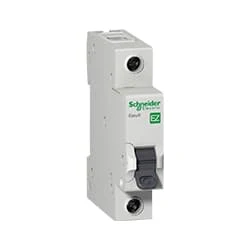Manual Transfer Switch In Contactor wiring:
This diagram shows how to make a Manual Transfer Switch In Contactor wiring. Auto manual wiring diagram. In this circuit, we use a magnetic contactor, and two SP MCBs, ( Single Pole Miniature Circuit Breaker ). This circuit is very simple and easy to make. Now this circuit is ready for use. If you want to know more about this circuit please check our youtube video below the post.
Diagram of Transfer Switch wiring:
Components Need for this Project:
You can get the components from any of the sites below:
Read Also:
Components used to make the Auto manual wiring:
01. Magnetic Contactor
 |
| Fig 2: Magnetic Contactor |
A magnetic contactor is an electrical device used for load control, automation, and protection. It is much like a magnetic reel. However, relays are generally used for low power and voltage, on the other hand, when we think of high power, these heavy-duty contractors only come to mind. It basically works by switching the load on and off. It has 3 terminals whose inputs are denoted as L1, L2, L3, and outputs as T1, T2, and T3. The circuit of the load is made in automation mode or protection using auxiliary contacts. It has two types of terminals. 1) Normally Open (NO). 2) Normally Closed (NC)
02. SP MCB
 |
| Fig 3: SP MCB |
MCB SP means single pole it protects only one phase switching. MCB (Miniature Circuit Breaker) Curswitch is the most basic general-purpose switch that you use to control a light or another device from one location. These Switches Have Two Brass-Colored Screw Terminals Connected to the hot Power Source Wires. (MCB) For any Distribution Board, the Protection System Must be Used in The Incomer. Phase and Neutral Single Phase Supply to break. 120-volt circuits, 15-20 amp single pole breaker is typically used.
Thank You for visiting the website. Keep visiting for more Updates.
Frequently Asked Questions
A manual transfer switch allows you to start a generator and restore the power supply to a predetermined circuit diagram when the utility power supply fails. This is a reliable, simple, and cost-effective method to provide building power supply owners with a high level of safety and security Circuit Diagram.
Unlike a manual transfer switch, automatic transfer switches can be used with permanently project system-installed standby generators. That way, when your power supply is disrupted and your company is subject to blackouts, your generator will automatically kick on and power supply emergency backup power supply to your building.
Non-automatic and Transfer Switches (NTSs) transfer loads to an alternate source when prompted by an operator Project system through electrical controls. Manual Transfer Circuit Diagram Switches (MTSs) require someone to manually transfer loads using external operating handles on the power supply equipment.
There are two types of automatic transfer switches, circuit breakers and contactors. The circuit diagram breaker type has two interlocked circuit breakers, so only 1 breaker can be closed at any time.
The principal purpose of an ATS is to ensure the continuous delivery of an electrical power supply from one of two power sources to a connected load circuit diagram (electrical equipment – lights, motors, computers, etc).


Post a Comment
Do leave your comments